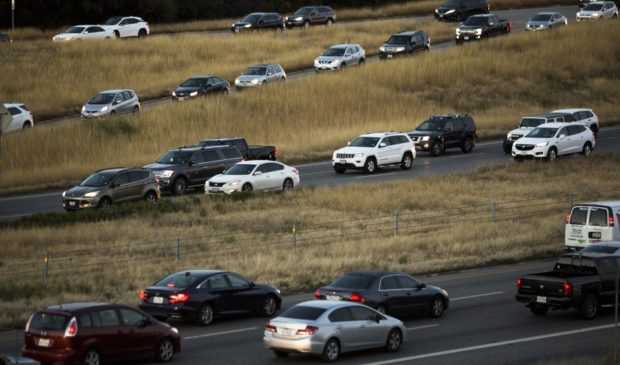Photo by Gabriel C. Pérez/KUT
As climate crisis deepens, Austin looks to speed up emission reductions
Thursday, September 9, 2021 by
Mose Buchele, KUT Austin would effectively emit zero greenhouse gases 10 years earlier than previously planned if a new proposal from city staff comes to fruition – but the goal would require a dramatic acceleration of the progress the city has already made toward its climate targets.
The draft for the city’s Climate Equity Plan says the more ambitious timeline – to reach “net zero” emissions communitywide by 2040 – is a reaction to City Council directives as well as the latest reports from the Intergovernmental Panel on Climate Change and the United Nations.
“Recent science shows that climate change is happening even faster than first thought,” says a memo sent Tuesday to the City Council along with the draft plan. “Our community is already feeling the impacts today in the form of floods, drought, wildfires, extreme heat, and even severe winter storms.”
To tackle that challenge, the Climate Equity Plan suggests cutting emissions earlier and faster than previously outlined.
“Instead of it being a straight line reduction from 2020 to 2050, it looks a little bit more like a slide,” said Zach Baumer, Austin’s climate program manager. “So it’s steep in the initial years and then it sort of flattens out in the later years.”
Under the plan, achieving earlier greenhouse gas reductions hinges on introducing new policies to cut emissions from buildings, encourage transportation electrification, and reduce car dependence by increasing housing density and mixed-use developments.
The plan also outlines proposals to cut emissions from the city’s food and waste system and develop land use policies to create “carbon sinks” to keep CO2 from escaping into the atmosphere.
The success of the Climate Equity Plan is also contingent on the success of other local climate programs, including an Austin Energy plan to phase fossil fuels out of its energy portfolio and Capital Metropolitan Transportation Authority’s Project Connect initiative to get more people on low- or zero-emissions public transportation.
“The other focus that you’ll see in the plan is a focus on equity and racial equity,” Baumer said. “In this plan, we’re really focused on trying to do the right thing for the environment and maximize emission reductions and also try to improve social equity and racial equality.”
The Challenges Ahead
Like the city’s previous climate equity plan, the latest proposal allows for the use of carbon offsets to cancel out emissions.
Carbon offsets allow companies and governments to continue to emit greenhouse gases while claiming to offset those emissions by removing CO2 from the atmosphere. While many believe removing existing atmospheric CO2 will be essential to avoiding the worst of climate change, critics say offsets can often amount to accounting gimmicks that allow for continued emissions.
Baumer says the plan’s use of offsets reflects the reality of the challenge the city faces.
“Is there going to be zero gasoline usage in the city in 20 years? Likely not,” Baumer said. “So the idea is that we need to address just that question of if you’re saying zero, what do you really mean?”
But, he pointed out, the new plan contains added language about how offsets should be “a last resort” and be capped at 10 percent of the amount of reductions the city is claiming on any given year.
The draft also highlights the ways in which local efforts alone are insufficient to meet the challenge of a heating world.
The city of Austin, it notes, is only responsible for less than half of the total amount of greenhouse gases emitted by the larger Austin-Round Rock-San Marcos Metropolitan Statistical Area.
“We need to be working together,” Baumer said. “Because Austin just getting its emissions to zero doesn’t fix or stop climate change.”
City Council is expected to consider the new Climate Equity Plan on Sept. 30.
Photo caption: Vehicles travel on MoPac Expressway during rush hour traffic in December 2018.
This story was produced as part of the Austin Monitor’s reporting partnership with KUT.
The Austin Monitor’s work is made possible by donations from the community. Though our reporting covers donors from time to time, we are careful to keep business and editorial efforts separate while maintaining transparency. A complete list of donors is available here, and our code of ethics is explained here.
You're a community leader
And we’re honored you look to us for serious, in-depth news. You know a strong community needs local and dedicated watchdog reporting. We’re here for you and that won’t change. Now will you take the powerful next step and support our nonprofit news organization?




